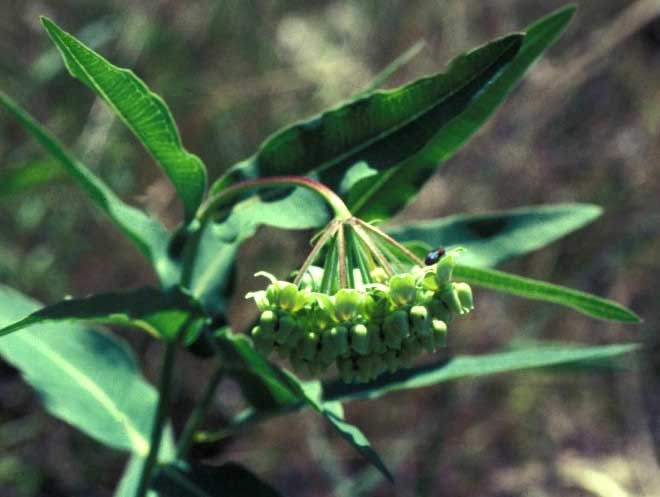Asclepias meadii , Photo: US Forest Service Cladus: Eukaryota Name Asclepias meadii Torr. ex A.Gray References * Manual ed. 2:704. 1856 -------- Asclepias meadii is a rare species of milkweed known by the common name Mead's milkweed. It is native to the American Midwest, where it was probably once quite widespread in the tallgrass prairie.[1] Today much of the Midwest has been fragmented and claimed for agriculture, and the remaining prairie habitat is degraded.[1] The plant is a federally listed threatened species due to this destruction of its habitat.[1] Factors contributing to its rarity include mowing and plowing, erosion, loss of a natural prairie fire regime, pesticides directly applied or drifting from nearby agricultural operations, invasive plant species, trampling by hikers, loss of native insect pollinators, and predation by a number of insect species.[1] Distribution The only naturally-occurring populations of the plant are located in Missouri and Illinois, and populations have been reintroduced to Indiana and Wisconsin, where the plant had been extirpated.[2] There are also some populations in Kansas and Iowa, but few of these may last, especially in Kansas, where they occur on private hay fields that are mowed frequently.[2] Description This is a rhizomatous perennial herb with a waxy erect stem growing up to about 40 centimeters tall. Blue-green, herringbone-patterned leaves occur in opposite pairs about the stem. The lance-shaped blades are smooth and sometimes wavy along the edges, and measure up to 8 centimeters long. The inflorescence is a nodding umbel of 6 to 23 fragrant flowers. Each flower has five petals up to a centimeter long which are green or purple-tinged when new and grow paler as they age. Behind them are five reflexed sepals. The flowers are nectar-rich[2] and are pollinated by digger bees (Anthophora spp.), bumble bees (Bombus spp.),[3] and other bees. The fruit is a follicle up to 8 centimeters long containing hairy seeds. The species is long-lived, taking at least four years to reach sexual maturity and living for several decades,[3] possibly over a century.[1] Reproduction The species often reproduces vegetatively by sprouting more stems from its rhizome. It also sometimes reproduces sexually by producing seed. A reduction in genetic diversity is a threat to the species, because human activity and other processes have favored vegetative reproduction, a cloning of the plants that does not remix genes.[2][4] Mowing chops off the flowers or immature fruits, preventing seed production.[2] Fragmentation of the habitat reduces the number of nearby plants that can trade pollen and the likelihood of visits from common pollinating insects.[1] Fire ecology The plant is adapted to occasional prairie fire, and the suppression of such fires is detrimental. [5] Fire may have a number of beneficial fire ecology effects on the plant, including increases in leaf and flower production and in genetic diversity. [6] Insect ecology Insect pests that eat the plant include the milkweed beetles Tetraopes femoratus and Tetraopes tetraophthalamus and the milkweed weevils Rhyssematus annectans and Rhyssematus lineaticollis.[3] This plant, like many other milkweeds, hosts the Monarch butterfly (Danaus plexippus).[3] References 1. ^ a b c d e f The Nature Conservancy
Source: Wikipedia, Wikispecies: All text is available under the terms of the GNU Free Documentation License |
|

